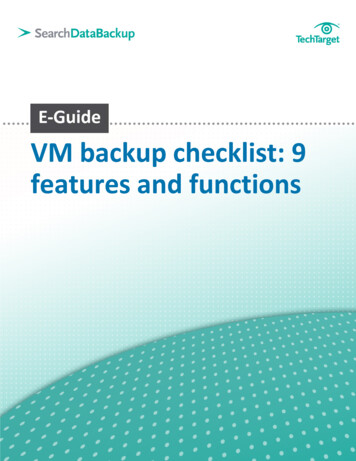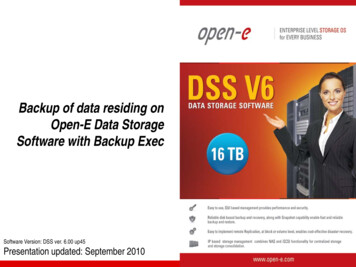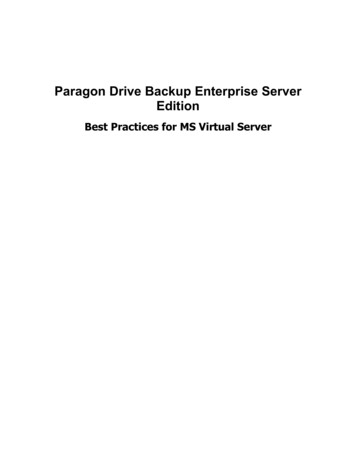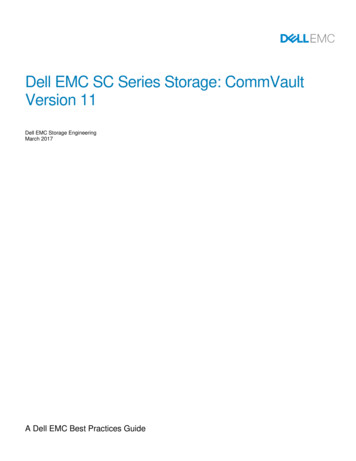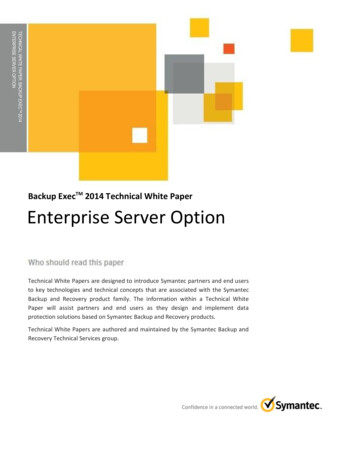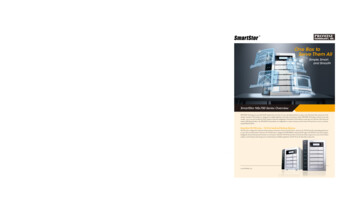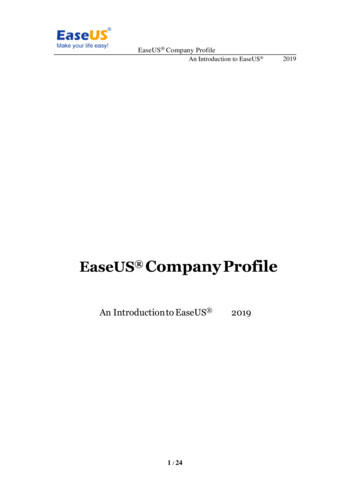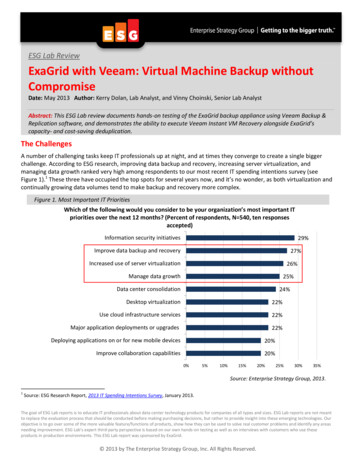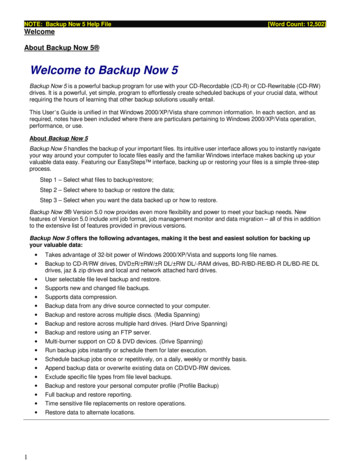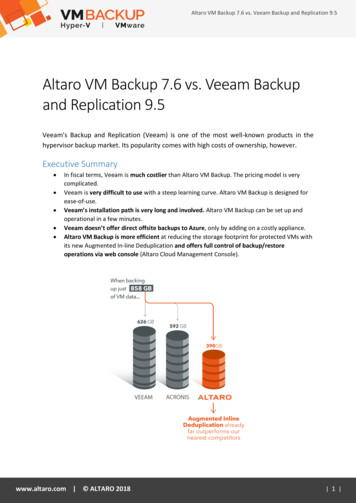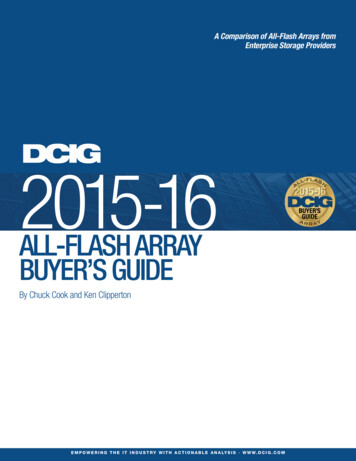
Transcription
A Comparison of All-Flash Arrays fromEnterprise Storage Providers2015-16ALL-FLASH ARRAYBUYER’S GUIDEBy Chuck Cook and Ken ClippertonE M P O W E R I N G T H E I T I N D U S T R Y W I T H A C T I O N A B L E A N A LY S I S · W W W. D C I G . C O M
2015-16 ALL-FLASH ARRAY BUYER’S GUIDEA Comparison of All-Flash Arrays from Enterprise Storage ProvidersTable of Contents1Introduction24141414151617The Value This DCIG Buyer’s Guide Creates for BuyersExecutive Summary44455555566All-Flash Arrays Now Replacing Traditional EnterpriseArrays in Mainstream BusinessesA Systemic Opportunity to Speed Up the BusinessProducing More, Spending LessImpact #1: Accelerates ApplicationsImpact #2: Enables New Revenue Opportunitiesthrough Real-time ApplicationsImpact #3: Creates Significant Savings in the OverallData Center BudgetImpact #4: Multiplies Existing Data Center CapacityImpact #5: Dramatically Reduces StorageManagement Overhead, Increases IT ResponsivenessImpact #6: Eliminates Time and Stress of Diagnosing,Mitigating and Documenting Performance ProblemsImpact #7: Increases Software Developer ProductivityThe Role of this Buyer’s Guide7How to Use this Buyer’s Guide8Disclosures8Inclusion and Exclusion Criteria8The 8-Step Process Used to Scoreand Rank the Arrays9DCIG Comments and Thoughts910101011111111121212121212131313AFA’s Evaluated for General Purpose EnterpriseStorage Requirements, Not Lowest LatencyBest Practice Includes ReviewingAll Performance Resources End-to-EndAll-Flash Arrays Accelerate Random I/O,Not Sequential I/OArray Series vs. Individual ModelsThe Barriers to AFA AdoptionSubstantially ReducedAutomated Storage ProvisioningAutomated Storage TieringData EfficiencyEncryptionFlash OptimizationManagement MethodsMicrosoft Technologies Gaining TractionIntegration with Key Enterprise ApplicationsQuality of Service (QoS)New Enterprise Expectation: Proactive RemediationSupport for VMware Storage PrimitivesFeature Areas Where DCIG Expectsto See ImprovementDCIG Observations & RecommendationsBest-in-Class RankingRecommended RankingExcellent RankingGood RankingBasic Ranking18All-Flash Array Rankings20All-Flash Array 424344454647484950AMI StorTrends 3600i SeriesDell Compellent SC8000Dell EqualLogic PS6210SDell Storage SC4020EMC VNXe3200 Unified All-Flash ArrayEMC XtremIO X-BrickFUJITSU Storage ETERNUS DX200FHitachi Data Systems HUS VMHP 3PAR StoreServ 7000c SeriesHP 3PAR StoreServ 8000 SeriesHP 3PAR StoreServ 20000 SeriesHuawei OceanStor 18800FIBM FlashSystem 900IBM FlashSystem V9000iXsystems TrueNAS Z50 TrueFlashKaminario K2 All-Flash Storage ArrayNetApp AFF8000 SeriesNetApp EF-SeriesNimbus Data Gemini SeriesOracle FS1-2Pure Storage FA-400 SeriesPure Storage FlashArray//m SeriesSolidFire SF SeriesTegile IntelliFlash T3000 SeriesViolin Memory Violin 6100 Series All Flash ArrayViolin Memory Violin 6264Violin Memory Violin 7000 Flash Storage Platform SeriesViolin Memory Windows Flash ArrayX-IO Technologies ISE 860 G3Product Rankings DashboardAppendicesA-1 Appendix A—Definitions, Explanations and TerminologyB-1 Appendix B—Vendor Contact InformationC-1 Appendix C—Author Contact InformationLicensed to Hewlett-Packard Corporation with unlimited and unrestricted distribution rights. 2015 DCIG, LLC. All rights reserved.i
2015-16 ALL-FLASH ARRAY BUYER’S GUIDEA Comparison of All-Flash Arrays from Enterprise Storage ProvidersIntroductionDCIG is pleased to present this fresh snapshot of the dynamic all-flash array (AFA) marketplace. This marketplace is dynamic both in terms of product evolution and in the rate ofall-flash array adoption. Many businesses are realizing that the time has come to run all oftheir application workloads on flash. The DCIG 2015-16 All-Flash Array Buyer’s Guide willhelp those businesses accelerate the all-flash array selection process.We began covering this nascent storage array category in 2012. At that time, storage appliances that permanently store data on flash memory were commonly being referred to aseither flash memory storage arrays or as all-flash arrays. In the time since the publicationof the DCIG 2014-15 Flash Memory Storage Array Buyer’s Guide, the storage industry hasembraced the term all-flash array. For that reason this refresh of the buyer’s guide is beingcalled the DCIG 2015-16 All-Flash Array Buyer’s Guide.More than terminology has changed over the last eighteen (18) months. The fresh dataDCIG compiled on forty-eight (48) arrays from eighteen (18) storage vendors shows thatall-flash array vendors have substantially reduced the barriers to all-flash array adoption.Consider the following facts drawn from comparing the 2014-15 and the 2015-16 data: Flash capacity is up 2x to 4x. Compared with the arrays in the 2014-15 edition, the averageraw flash memory capacity nearly quadrupled from 117 TB to 445 TB. Median andmaximum raw flash memory capacities more than doubled to 88 TB and 3.9 PB per array.Effective capacity after deduplication and compression is a multiple of these numbers. Flash density is up 50%. Average raw storage density rose 50%, from 14 TB/U to 21.5TB/U. Median density is now 19.2 TB/U. Maximum density is 51 TB/U of high performance flash memory. Effective storage density (after deduplication and/or compression)is a multiple of these numbers. This combination of all-flash performance and highstorage density means that an AFA can meet performance and capacity requirements in1/10th the space of legacy storage systems. Entry prices are down 50% to less than 25,000. The entry point list price is less thanhalf what it was in 2014. Several all-flash arrays now carry a starting list price of less than 25,000, placing all-flash performance within the reach of many more businesses. Majority of shipping configurations are under 250,000 list price. Among vendors thatreported the list price of a typical configuration as ordered by customers, three (3) reporta list price under 100,000; three (3) between 100,000 and 150,000; and fourteen (14)between 150,000 and 250,000.Although /GB is probably the least favorable way of evaluating flash memory costs, it is ametric familiar to many storage purchasers. Multiple vendors now claim a cost per GB—afterdeduplication and compression—of 2 or less. This compares favorably with traditional 15Khard disk drives (HDD) costs, though still a multiple of the cost for NL-SAS HDDs.This Buyer’s Guide includes data sheets for 28 arrays from 18 storage vendors. These 28arrays represent the highest scoring array from each product series. Vendors with productsincluded in this guide are AMI, Dell, EMC, Fujitsu, Hitachi Data Systems, HP, Huawei, IBM,iXsystems, Kaminario, NetApp, Nimbus Data, Oracle, Pure Storage, SolidFire, Tegile, ViolinMemory and X-IO Technologies.Licensed to Hewlett-Packard Corporation with unlimited and unrestricted distribution rights. 2015 DCIG, LLC. All rights reserved.1
2015-16 ALL-FLASH ARRAY BUYER’S GUIDEA Comparison of All-Flash Arrays from Enterprise Storage ProvidersIntroduction(continued)The first wave of all-flash arrays had limited capacity and limited data services. As a result,early adopters used these appliances to address specific storage-related pain points: Increasing the performance of business-critical database applications and enablingreal-time applications (through ultra-low latency) Enabling successful and cost-effective virtual desktop deployments (ability to handleboot storms, high deduplication ratios make the cost per desktop reasonable) Solving virtual server application performance issues (ability to handle highly random I/O)While these early drivers will continue to be important, we believe that a broad set offeatures will be important to the next wave of all-flash array purchasers including: Ability to manage multiple tiers of storage performance and endurance Comprehensive data services (thin provisioning, snapshots, replication,deduplication, compression) Ease of integration into existing data center environments Integration with key enterprise applications Granular performance monitoring Non-disruptive upgrades Provisioning automation Quality of service (QoS) Scalable capacity Storage density per rack unit Unified management and/or open management interfaces(SMI-S, OpenStack Cinder, etc)This Buyer’s Guide evaluates products on the comprehensive set of features expected ofan enterprise storage array rather than expectations for a niche high-performance storageappliance. Some of the arrays in this guide intentionally eschew enterprise data servicesin order to attain the lowest possible I/O latencies. This lack of data services lowered theirrankings in this Buyer’s Guide. Consequently, enterprises focused on getting the absolute maximum performance from their critical database applications may find that a lowerranked array is a better fit than some of the higher ranked arrays.The Value This DCIG Buyer’s Guide Creates for BuyersThis introduction to the current state of the all-flash array market is only the tip of theiceberg. Like all prior DCIG Buyer’s Guides, the DCIG 2015-16 All-Flash Array Buyer’sGuide does the heavy lifting for organizations as they look to purchase an all-flash array by: Providing a succinct analysis of the AFA marketplace Delineating and normalizing array features, whether or not they are supportedand where appropriate how they are implementedLicensed to Hewlett-Packard Corporation with unlimited and unrestricted distribution rights. 2015 DCIG, LLC. All rights reserved.2
2015-16 ALL-FLASH ARRAY BUYER’S GUIDEA Comparison of All-Flash Arrays from Enterprise Storage ProvidersIntroduction(continued) Weighting these features according to what end users considermost important in a primary storage array Ranking each model (or series) Creating a standardized one-page data sheet for each model (or series)The end result is that the DCIG 2015-16 All-Flash Array Buyer’s Guide drives time and costout of the product selection process by enabling prospective buyers to do “at-a-glance”comparisons between many different arrays. By identifying a short list of products that meettheir specific needs, prospective purchasers can focus their product evaluation energies onthose selected arrays and move more quickly to the competitive bid process.Note that this Buyer’s Guide is not intended to be a substitute for bringing individual modelsin-house for testing. That function should still be done, if possible, since every array willperform differently under different application workloads and data center environments. Wehope you find that this Buyer’s Guide meets its intended purpose in your environment.Chuck and KenLicensed to Hewlett-Packard Corporation with unlimited and unrestricted distribution rights. 2015 DCIG, LLC. All rights reserved.3
2015-16 ALL-FLASH ARRAY BUYER’S GUIDEA Comparison of All-Flash Arrays from Enterprise Storage ProvidersExecutiveSummaryThe marketplace for all-flash arrays is both rapidly growing and highly competitive. Manychanges have taken place in the all-flash array marketplace in the 18 months since therelease of the DCIG 2014-15 Flash Memory Storage Array Buyer’s Guide in March of 2014.We have witnessed substantial increases in capacity, storage density and performance. Overthis same period, AFA’s have established a track record of dramatic application accelerationand proven reliability.All-Flash Arrays Now Replacing Traditional Enterprise Arraysin Mainstream BusinessesWhen we prepared the previous edition of this Buyer’s Guide, multiple vendors indicated thatprospective customers were looking to move to an all-flash environment for their critical business applications. These same vendors report that enterprises are now looking to use flashmemory not just for critical applications, but for all active workloads in the data center. In arecent study1 by 451 Research, 22% of respondents have already implemented an all-flasharray. Of those, 57% were using the array to speed up multiple applications and 26% hadfully replaced legacy arrays.The return on investment (ROI) of using flash for all active workloads already made sense in2014. Subsequent improvements in all-flash performance and costs make the ROI of movingto all-flash storage compelling. As a result, enterprises will increasingly replace primary enterprise storage systems with all-flash arrays.Enterprises wanting to change storage vendors will discover a robust and competitivemarketplace. Multiple vendors have created new storage architectures designed from theground up for flash memory and have created new expectations around ease-of-use andanalytics-based proactive support.Enterprises that are generally happy with their current storage vendor and storage system(performance issues aside) are likely to find an all-flash version of the storage system isavailable. Such businesses can realize some or all of the benefits of an AFA without the riskassociated with migrating to a new storage architecture, and without having to re-implementdata protection strategies.A Systemic Opportunity to Speed Up the BusinessThe purchase of an all-flash array will be most easily justified—and have the greatest benefit—in businesses that think this through as a systemic data center and business opportunity.Many who do so will discover that “flash is free.” That is, the return on investment within theIT budget is rapid, and the business impact of accelerating all enterprise applications is thespeeding up of the entire business. As Eric Pearson, the CIO of InterContinental Hotels Groupwas quoted in Pat Gelsinger’s VMworld 2015 keynote, “It’s no longer the big beating thesmall. It’s the fast beating the slow.” 2Producing More, Spending LessEvery technology purchase must fulfill at least one of two objectives; it must enable the business to produce more, or it must reduce the cost of production. An AFA can fulfill both of1. Coulter, Marco. “Flash Storage Outlook.” Proc. of Flash Memory Summit 2015, Santa Clara, CA. Flash Memory Summit, 12Aug. 2015. Web. 28 Aug. 2015. ls/Proceedings/2015/20150812S203D Coulter.pdf .2. Pat Gelsinger on Stage at VMworld 2015, 15:50. YouTube. YouTube, 01 Sept. 2015. https://www.youtube.com/watch?v U6aFO0M0bZA&list PLeFlCmVOq6yt484cUB6N4LhXZnOso5VC7&index 3 .Licensed to Hewlett-Packard Corporation with unlimited and unrestricted distribution rights. 2015 DCIG, LLC. All rights reserved.4
2015-16 ALL-FLASH ARRAY BUYER’S GUIDEA Comparison of All-Flash Arrays from Enterprise Storage ProvidersExecutive Summary(continued)Executive Summarythese business objectives simultaneously. Early AFA adopters have discovered multiple ways(continued)to leverage the AFA investment to produce more and spend less.Impact #1: Accelerates ApplicationsFlash-based storage systems typically create a seven-fold improvement in applicationperformance. This acceleration saves money across the business. For example, the installation of an AFA at one growing business was directly attributed with avoiding the need to hirebetween 10 and 40 additional employees. Flash storage enabled the company to grow theirbusiness without growing their head count.3Impact #2: Enables New Revenue Opportunities throughReal-time ApplicationsFlash memory enables real-time applications by eliminating storage latency. For example,eliminating disk-related latency has proven to be a key enabler for individualizing recommendations and tailoring content in online shopping experiences, leading to increasedsales opportunities.Impact #3: Creates Significant Savings in the Overall Data Center BudgetA flash-storage-enabled rethinking of the data center can generally achieve hard costsavings of over 30% in data center hardware and software, and realize an ROI of less than11 months.4 Some businesses have found that the total cost of the AFA was lower than themaintenance cost of the former SAN.Impact #4: Multiplies Existing Data Center CapacityStorage is traditionally one of the largest consumers of data center capacity. AFA’s canachieve a 10x reduction in storage footprint. An AFA generally also enables a higher levelof server consolidation; reducing server footprint as well. The resulting opportunity toconsolidate data centers is real; eliminating current operating expenses and/or avoidingthe expense and time lag associated with adding another data center.Impact #5: Dramatically Reduces Storage Management Overhead,Increases IT ResponsivenessIT leaders tell us that all-flash arrays dramatically reduce the time IT staff spend managingstorage. The performance of flash memory means less time is required for planning aroundthe storage impact of adding another workload to the data center. Improved managementinterfaces and automation capabilities means less time is required for day-to-day management. As a result, the IT department is enabled to be more responsive to the business.Impact #6: Eliminates Time and Stress of Diagnosing, Mitigating andDocumenting Performance ProblemsMany businesses start looking at AFA’s because of poor application performance. AFAimplementers tell us that they no longer have to spend time diagnosing and mitigatingapplication performance issues; or explaining those issues to the rest of the business andto unhappy customers. These time and stress reductions ripple through the business: fromcustomer support, to IT staff and business managers.3. Floyer, David. “Case Study: The Hunting of the RARC.” http://wikibon.org/wiki/v/Case Study: The Hunting of the RARC4. Clipperton, Ken. “IBM Validates Systemic Data Center Savings Enabled by Flash Memory.” Licensed to Hewlett-Packard Corporation with unlimited and unrestricted distribution rights. 2015 DCIG, LLC. All rights reserved.5
2015-16 ALL-FLASH ARRAY BUYER’S GUIDEA Comparison of All-Flash Arrays from Enterprise Storage ProvidersExecutive Summary(continued)Impact #7: Increases Software Developer ProductivityMany corporate software developers test their software against old and/or partial data usingdedicated non-production storage systems. The zero-space clone capabilities of AFAscombined with AFA performance headroom enables developers to perform software testingagainst a full clone of the current data. Using the AFA makes testing better and faster, accelerating the path to successful software releases. It also enables the business to eliminate thenon-production storage systems.The Role of this Buyer’s GuideFor all the reasons listed above, many businesses are considering all-flash arrays for theirdata centers. The DCIG 2015-16 All-Flash Array Buyer’s Guide is pregnant with freshinformation that will accelerate the research process for those businesses and increase theirconfidence in the results of that research.As prior Buyer’s Guides have done, this Buyer’s Guide puts at the fingertips of organizationsa comprehensive list of all-flash arrays and standardized data sheets that can assist them inthis important buying decision. The use of this DCIG Buyer’s Guide will enable an organization to formulate an exact opinion on features that are most important to them, then generate a short list of products to do further research and/or acquire.This DCIG 2015-16 All-flash Array Buyer’s Guide accomplishes the following objectives: Collects and standardizes data about the features of available AFA models Provides an objective, third party evaluation of features from an end user’s viewpoint Provides insight into the current state of the marketplace and product features thatmay warrant particular attention Scores and ranks the features on each model based upon the criteria that mattermost to end users so they can quickly know which models are the most appropriatefor them to use and under what conditions Provides standardized data sheets for 28 all-flash arrays from 18 different storageproviders so end users can do quick comparisons of 98 features that are supportedor not supported on each model Gives any organization the ability to request competitive bids from different storageproviders that are apples-to-apples comparisonsLicensed to Hewlett-Packard Corporation with unlimited and unrestricted distribution rights. 2015 DCIG, LLC. All rights reserved.6
2015-16 ALL-FLASH ARRAY BUYER’S GUIDEA Comparison of All-Flash Arrays from Enterprise Storage ProvidersHow to Use this Buyer’s GuideIn determining how to best use the information containedin this DCIG Buyer’s Guide, it is important to note that it isintended to help organizations in their purchase of an all-flasharray by significantly reducing the time they must invest inresearching product features and capabilities. The purposeof this Buyer’s Guide is NOT to tell users exactly whichall-flash array to purchase. Rather, it is to help guide themin coming up with a list of competitive products that havecomparable features that may meet their specific needs.It is also important for users to note that just because a product scored the highest in a particular category or is rankeda certain way does not automatically mean that it is theright product for their organization. If anything, because ofthe scope of all-flash array models evaluated and analyzed,higher ranked models may have features that are too robustfor the needs of an individual department or organization.However, this Buyer’s Guide does give users some sense ofhow each array compares to others classified as “all-flasharrays,” as well as offering additional insight into what product offerings are available on the market.DCIG recommends that you use this DCIG 2015-16 All-FlashArray Buyer’s Guide in the following six (6) ways:3. Separate the apples from the oranges. Just asimportant as doing apples-to-apples comparisonsis identifying when an orange is thrown into the mix.Sometimes it is very difficult for an organization toknow if it is truly getting a good deal when bids comein from multiple storage providers that include differentmodels. Now organizations can refer to the rankingsof each all-flash array in this guide so they knowwhen they are getting a good deal, a great deal orjust an adequate one.4. Gain perspective on how models from less wellknown storage providers compare against established and better known brands. Anyone involvedwith storage at all has at least heard of Dell, HP andother well-known storage vendors. This creates acertain built-in level of comfort when buying productsfrom these companies and a corresponding built-inresistance to buying products from companies thatare perceived as unknown quantities.This Buyer’s Guide helps to remove some of thatapprehension about buying from a less well knownprovider or even a less well known model from anestablished provider. Using this Buyer’s Guide, organizations can see how these models from lesser knowncompanies as well as lesser known models fromestablished providers stack up.1. Eliminate the painstaking research associated withcoming up with a short list of all-flash arrays thatmeet their needs. This Buyer’s Guide contains datasheets for 28 different models from eighteen (18)different providers. Each array is scored and then rankedas Recommended, Excellent, Good or Basic basedupon its score. On each array, more than 100 differentfeatures were evaluated, weighted, scored and thenranked. All an organization has to do is look at therankings and features of each product in order to comeup with a short list of products for consideration.5. Take advantage of normalized storage terminology.Every computing industry has a proclivity to adoptacronyms and jargon that is specific to its lexicon, butthe data storage industry seems to go out of its way tonot only use unfamiliar terms but refer to the sametechnology in different ways. This Buyer’s Guide siftsthrough the acronyms and storage jargon and termsand normalizes them. This minimizes or even eliminatesthe need for users to try to understand all of theindustry terminology.2. Identify comparable apples-to-apples all-flasharrays from different storage providers. In today’scrowded storage market, it behooves organizations toget competitive bids from multiple storage providers.After all, when they compete, you win! But that tacticonly works well when organizations know that they arereceiving competitive bids on products that are roughlycomparable. Using this DCIG 2015-16 All-Flash ArrayBuyer’s Guide, organizations can do a better job ofaccomplishing that objective.6. Do side-by-side comparisons. The product data sheetsavailable from the different storage providers are rarelylaid out in the same way or contain the same information.Some storage providers even have data sheet formatsthat vary from model to model within their own productportfolio. This Buyer’s Guide tackles the problem bycreating a standard, easy to read data sheet for eachall-flash array. In this way, product data sheets forindividual products can be printed out, laid down side byside and then quickly compared.Licensed to Hewlett-Packard Corporation with unlimited and unrestricted distribution rights. 2015 DCIG, LLC. All rights reserved.7
2015-16 ALL-FLASH ARRAY BUYER’S GUIDEA Comparison of All-Flash Arrays from Enterprise Storage ProvidersDisclosuresOver the last few years the general trend in the US has been forboth large and boutique analyst firms to receive some or all oftheir revenue from storage providers. DCIG is no different in thisrespect as it also receives payment for the different services itperforms for storage providers. The services that DCIG providesinclude blogging, customer validations, product reviews, executive white papers, full length white papers and special reports.For more information on DCIG, visit www.dcig.com.In the interest of being fully transparent, a number of the storage providers included in this DCIG 2015-16 All-Flash ArrayBuyer’s Guide are, or have been, DCIG clients. This is not toimply that they were given preferential treatment in the Buyer’sGuide. All it meant was that DCIG was aware that they offeredarrays that might qualify for inclusion in this Buyer’s Guide andthat DCIG had more initial knowledge of their arrays.In that vein, there are a number of important facts to keepin mind when considering the information contained in thisBuyer’s Guide and its merit. No storage provider paid DCIG any fee to developthis Buyer’s Guide. DCIG did not guarantee any storage provider thatits array(s) would be included in this Buyer’s Guide. DCIG did not imply or guarantee that a specific arraymodel would receive a good ranking in this Buyer’sGuide ahead of time. All research was based upon publicly available information, information provided by the storage provider andthe expertise of those evaluating the information. Because of the number of features analyzed and howeach of these features were weighted, there was no wayfor DCIG to predict at the outset how individual arraymodels would end up ranking. Available as a rack-mountable appliance. Must be marketed as an all-flash array (AFA). The bestevidence of meeting this criterion is the existence of aspecific all-flash SKU. Must use flash memory as primary storage, not merelyas an extended cache. May permit storage expansion with disk shelves thatcontain HDDs or the virtualization of external disk-basedarrays—essentially converting the all-flash array intoa hybrid storage array. Must support one or more of the following storagenetworking protocols: iSCSI, Fibre Channel, InfiniBand, NFS. There must be sufficient information available to DCIG tomake meaningful decisions. DCIG makes a good faitheffort to reach out and obtain information from as manystorage providers as possible. However, products maybe excluded because of a lack of sufficient reliable data. Must be formally announced and/or generally availablefor purchase as of June 19, 2015. A cut-off date hadto be put in place or this Buyer’s Guide would neverbe published.Ultimately, it is the professional judgment of the analystsworking on each DCIG Buyer’s Guide whether or not aparticular model meets the inclusion criteria.The 8-Step Process Used to Score andRank the ArraysTo score and rank each array model, DCIG went throughan eight (8) step process to come to the most objectiveconclusion possible.Inclusion and Exclusion Criteria1. DCIG listed out all of the features available on all-flasharrays. Prior to selecting the features that were includedin the final evaluation in the Buyer’s Guide, DCIG wentthrough and quantified what features all-flash arrayspossessed. As part of this process, DCIG “normalized”the list of available features such that a common namefor each feature was established.The inclusion and exclusion of specific array models in thisBuyer’s Guide is based on the follow criteria:2. DCIG established which features would be included inthe Buyer’s Guide and which ones would not. One ofDCIG would like to emphasize that no storage provider wasprivy to how DCIG did the ranking of the arrays. In everycase the storage providers only found out the rankings ofits array model(s) after the analysis was complete.Licensed to Hewlett-Packard Corporation with unlimited and unrestricted distribution rights. 2015 DCIG, LLC. All rights reserved.8
2015-16 ALL-FLASH ARRAY BUYER’S GUIDEA Comparison of All-Flash Arrays from Enterprise Storage Providersthe goals of this Buyer’s Guide was to try to onlyinclude features that could be objectively and authoritatively analyzed.For example, “Raw Flash Capacity per Appliance (Max)”was evaluated as a feature instead of “Useable StorageCapacity.” While useable storage capacity is what usersultimately care about, a consistent objective answercannot be arrived at as most arrays offer multiple RAIDoptions and differences in data compression anddeduplication by type of data yield site-specific useableor effective storage capacity. Therefore,
23 Dell EqualLogic PS6210S 24 Dell Storage SC4020 25 EMC VNXe3200 Unified All-Flash Array 26 EMC XtremIO X-Brick 27 FUJITSU Storage ETERNUS DX200F 28 Hitachi Data Systems HUS VM . deduplication and compression—of 2 or less. This compares favorably with traditional 15K hard disk drives (HDD) costs, though still a multiple of the cost for NL .

